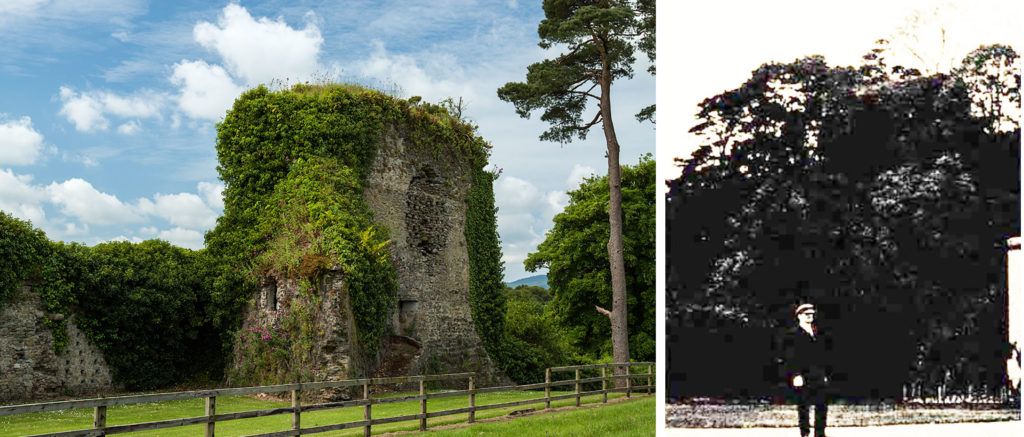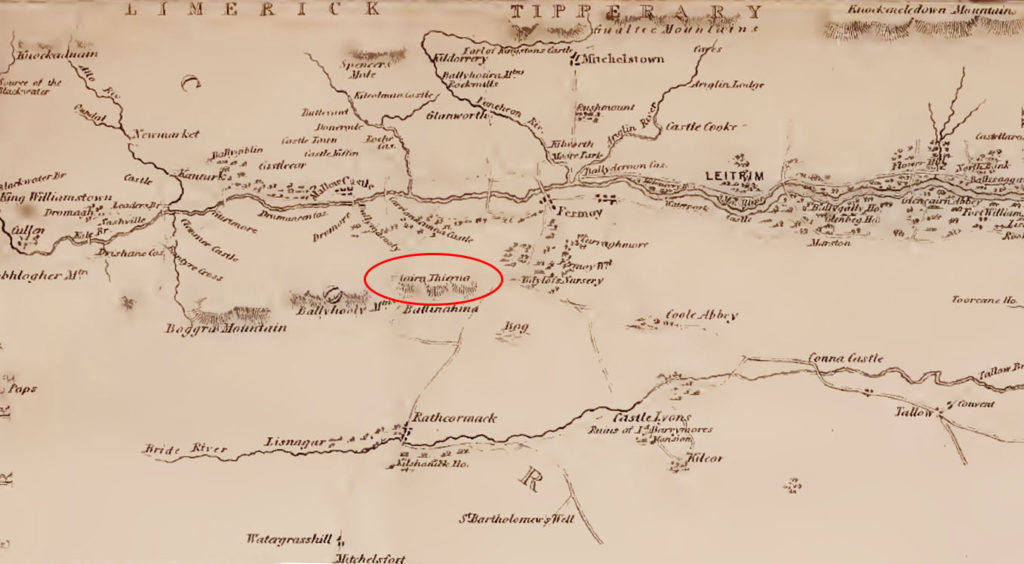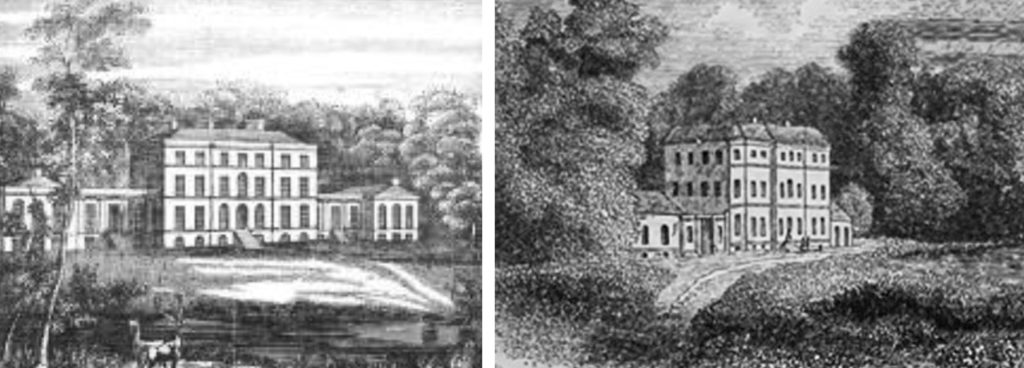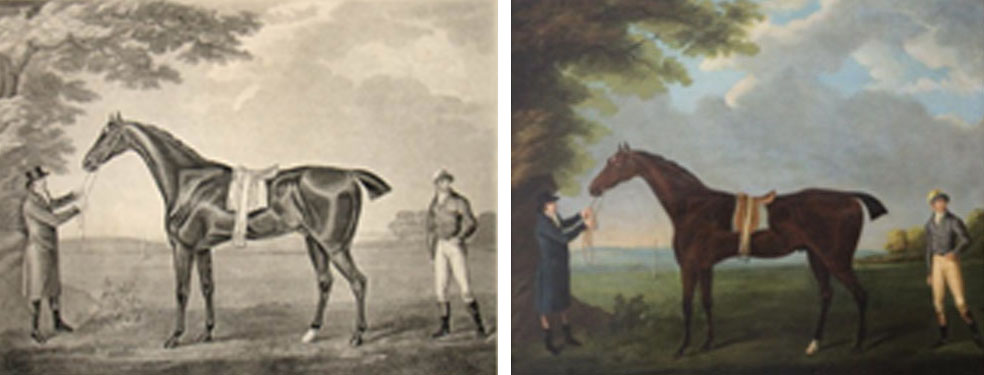A series of dances was held in Fermoy, Co Cork, in August 1847 ‘to cheer every heart so long clouded by the distress and gloom now rapidly passing away,’ an account of which is held in the Castleisland O’Donohoe Collection.[2]
None of the dances, however, surpassed the fete champetre in the grounds of Carriganedy Castle and the mansion house of Castle Hyde.[3]

Carriganedy Castle, according to tradition, was built by the O’Mahonys.[5] The research of Canon John O’Mahony, one-time priest of the Cork parish of Kilmurry, suggested the construction of a castle in this territory may have been outside the hereditary sept-land.[6]
The life and times of O’Mahony at Carriganedy Castle remain open to research. Other names, Condon and Maloney, also come down from the ancient history of the castle.[7]
It has been suggested that the castle, built on a rock – ‘the rock of the shield’ – dates to the fifteenth century.[8]
A legend of nearby Cairn Thiernia survives, which tells how the Lord of Fermoy was building a castle for his son on a hill. During the course of construction, his lordship showed the work to his son. The boy, looking into the water used to wet the lime for mortar, mistook his reflection for a playmate, entered the water, and was drowned.[9]

Hyde of Castle Hyde
By the late sixteenth century, the family of Hyde was in residence. During the Rebellion of October 1598, Carrignedy Castle was captured.[10]
The Hydes retained the lands and Carriganedy Castle became more familiarly, Hyde Castle, moreso when a mansion house, Castle Hyde, was erected in the grounds of the castle.
The rear of Castle Hyde Mansion is sheltered from the north by giant cliffs. On the summit stands the ruined walls of the castle of Carrigansady … when the distribution of the forfeited estates of the Earl of Desmond in Cork, Limerick, Kerry, Tipperary and Waterford was made by Sir John Popham, the English Attorney General, and Sir Edward Phytor, six thousand acres were granted to Arthur Hyde at one penny an acre, and twelve thousand acres, at the same rate, to Phane Becher … Here for nearly three centuries Hyde ruled.[11]

Castle Hyde, ancestral home of Douglas Hyde (1860-1949), President of Ireland, was, in early times, enshrined in song:
As I rode out on a summer’s morning, Down by the banks of Blackwater side, To view the groves and meadows charming And pleasant gardens of Castle Hyde. It is there you will hear the thrushes warbling, The dove and partridge I now describe, The lambkins sporting each night and morning All to adorn sweet Castle Hyde.[13]
Castle Hyde also developed a reputation for its stables. On 17 February 1801, a famous racehorse named Diamond arrived at the mansion, then the home of Colonel Arthur Hyde. Every village through which Diamond passed on his journey to Cork ‘resounded with nothing but his name and praises of his beauty’:
It is with pleasure we announce the safe arrival of Diamond, at twelve o’clock, on the 17th instant, at Castle Hyde, in the county of Cork, the seat of Colonel Arthur Hyde, his new Master. He was two days and two nights on his voyage from Holyhead to Dublin, during which time he encountered much boisterous weather. Notwithstanding this disadvantage, and that horses suffer very much at sea at all times, he reached his destination in as good health and condition as when he set out from London.[14]

Less than one year later, Colonel Hyde died, and soon after, Diamond, and others including Sir Harry, Superior, Turnip and Scrub, were up for sale.[15]
Castle Hyde in Modern Times
The fortunes of Castle Hyde and the Hyde family, and the subsequent history of the mansion, are traced in Terence Dooley’s Castle Hyde: the fall and rise of an Irish country house (2017). This includes the restoration of Castle Hyde – hailed as ‘the most successful restoration project in Irish history’ – by celebrated dancer Michael Flatley, who purchased the property in 1999.[16]

In 2005, the proud owner of Castle Hyde, during an interview for Tiger Feet, spoke about his work ethic:
The saying was in our house, the Flatleys work every day … one Sunday afternoon in the midst of summer, I said to my father … Dad, why do we have to work every Sunday? And he threw the shovel down in the ditch and he said, so that when you grow up you won’t have to.[17]
Meanwhile, Carriganedy Castle, and the mansion house of Castle Hyde, await the next chapter in their considerable histories. Castle Hyde has been on the market for some years.
__________________
[1] Variations include Cariganedy, Carriganeedy, Carriganeide, Carraig an Eidigh,Carraig an Eidig, O Eideac de Cappa, Carrickgenede, Cahirganned, Carrigen Eddy, Carrigin-Eddy, Carigynedy, Carigenedy. Carraig an Ide, Karrigynedy, Karrighinedy, Carrigynedy, Carrignedy, Crrignedith, Carriginedye, Carrygnedye, Carriganeady, Carrickenedie, Carrigunsady. [2] IE MOD/C75. A series of dances was held in a number of mansion houses in the district including Mitchelstown Castle and Richmond House as the country emerged from the Great Famine. Mitchelstown Castle, residence of the Earl of Kingston and Richmond House, residence of Henry Smyth, JP. Others venues included New Barrack House, residence of Captain O’Flanagan; Kilmurry House, residence of Thomas St John Grant JP and St James’s Place, residence of Major H Darby Griffiths, Scots Greys. [3] The event was held by the ‘Bachelors of the Fermoy Garrison.’ [4] Image © Mike Searle 2015 Creative Commons Licence. https://www.geograph.ie/photo/4570530. [5] ‘Tradition places an old castle West of Fermoy, Carriganedy, in the vicinity of Castlehyde, to have been built by the O’Mahonys’ (Southern Star, 1 February 1958). [6] A History of the O’Mahony Septs of Kinelmeky and Ivagha (1913), p55: ‘As Kinelea, though ecclesiastically divided, was one tribal sub-denomination, we can make out only six of the "nine territories" from the seven Deaneries enumerated. A seventh territory would be Musgrylin (Murgraide Flainn or Floinn) a Deanery, comprising a number of parishes between the Blackwater and the Lee, belonging to the original Diocese of Cork (according to the Synod of Rathbreasil), but attached to Cloyne subsequently. There remain two territories unidentified. Hence it may be concluded that Mahon must have acquired two other districts outside his old hereditary Sept-land and outside the Diocese of Cork. Where are we to look for these? Perhaps some light is thrown on the question by the place-name Dunmahon, and by the tradition mentioned by Smith in the following passage of his History of Cork (p. 320, New Ed.) : —"To the west of Fermoy lies Carriganedy, i.e., the rock of the shield, where stood a castle (qu. Dun?), said to have been built by the Mahonys".’ Very Rev John Canon O’Mahony died at Crookstown, Co Cork, on 4 January 1912. Obituary and photograph, Cork Examiner, 5 January 1912. ‘In the Dublin copy of the Annals of Ulster, the chronology of which is correct from this year forward, it is stated under the year 1381, that this Dermot Mac Carthy was treacherously slain by the O’Mahonys of Fonn Iartharach or the Western Land. This district, which was otherwise called Ivahagh, extended, according to Carbria Notitia, from Ballydehob to Dunmanus Bay in the south-west of the county of Cork. According to the Regal Visitation Book of 24 July 1615, the deanery of Foneragh (ie Fonn-Iartharach), comprised the parishes of Kilmore, Scool, Kilcrohane, Durris, Kilmaconoge and Cathragh and there can be no doubt that the country of O’Mahony the Western originally comprised these parishes’ (Annals of the Kingdom of Ireland by the Four Masters (1848) edited by John O’Donovan). [7] ‘O Malowne Malone Malown Mallowney Moloney –This family name is given as a principal name in Co Cork in the census of 1659. Note Castle Cregg and Carriganeide are found connected to the name in times past’ (O’Laughlin, Families of Co Cork). ‘Fermoy – territory of O’Keeffe, granted about 650 years ago to the Norman, De Caunton or Condon, whose numerous castles in the district extend as far as Mitchelstown, so called from Mitchel Condon of Carriganure (or Danagh) their most northerly castle … Condon had supported Desmond in rebellion and consequently his property was forfeited and granted in 1587, part to Fleetwood and Redmayne, and part to Hyde’ (‘Ancient Castles of Fermoy District. Relics of the Condons.’ The Cork Examiner, 25 April 1931). ‘Castle Hyde, the noble seat of John Hyde Esq. This place was anciently called Carrig-a-neady, or the Rock of the Shield and the remains of an old castle of the Condons, clad in a rich mantle of ivy, still rears its venerable head amid the environing trees’ (The Blackwater in Munster (1844) by J R O’Flanagan, p113). [8] Carriganedy Castle dates to the 15th century (Irish Independent, 13 November 1999). [9] The Blackwater in Munster (1844) by J R O’Flanagan, ‘The Haunted Huntsman – A Tale of the Blackwater Side’, pp71-77. ‘I stopped for a moment and beheld Castle Hyde forenent me at the other side of the river, looking very grand, with the tall black woods behind it … behind me was Cairn Thierna rising like a great giant in the sky; and I saw the heaps of stones on the top looking like human craturs. I thought of the quare story they tell about the place; how the lord’s son was to be drownded, and how the father was building the castle for him atop of the hill, and how he tak him to see it one day and the poor gossoon went to look into the big tub, where they wet the lime for mortar, and saw, as he thought, another little boy in the tub, and climbed in to play with him, and got drownded; and how the stones quarried for the castle remain on the top of the hill to this day.’ There are variations of this tale; see the Legend of Cairn Thierna in The Schools’ Collection (Rathcormack, Co Cork) and The Tragedy of Cairn Thierna in Croker’s Fairy Legends and Traditions of the South of Ireland. [10] A meticulous account of Castle Hyde is found in Historical and Topographical Notes Etc Collected by Colonel James Grove White JP DL, Vol II, 1911, pp88-102. [11] ‘Recollections of Castle Hyde’ by J Roderick O’Flanagan BL, Journal of the Cork Historical & Archaeological Society, Vol I, 2nd Series, 1895, pp200-207. The fall of Carriganedy Castle is open to research. The early Ordnance Survey map names the ruined castle, ‘Castle Hyde.’ ‘The grants of forfeited lands under Queen Elizabeth usually give the form Carrigynedy for Castle Hyde and suggests that an earlier name for the area was Teampall logain … Carrigynedy would seem to derive from Carraig an Ide, Hyde’s Castle, or Castle Hyde, Temple logain may derive from Ui Cuain, a family who gave the name Tuath O Cuain to this district which extended across the Blackwater. Father Power was of opinion that Templenoe was the modern form of Temple logain and of the still earlier Rath Ugaine which occurs in the Book of Fermoy. Padraig O Maidin’ (Cork Examiner, ‘A Duel at Castle Hyde’ 16 April 1970). [12] The Blackwater in Munster (1844) was the work of James Roderick O’Flanagan (1814-1900), barrister and author, of Avondhu Grange, Fermoy, eldest son of John Fitch O’Flanagan Esq, barrack master, Grange Farm, Fermoy and Eliza Glissan. James, the younger of twins (a sister Helena), was born in the old barracks at Fermoy. He was called to the bar in 1838 and joined the Munster Circuit at Cork. He married in 1859 to Mary Theresa, eldest daughter of William Witham Esq of Cliffe and had issue three sons, journalist Roderick William (b1860), horticulturist Roland James (1863-1941) and Hubert (1865-1935), OMI, who joined the Oblates Order in 1887 and spent the greater part of his religious life at Belmont House, Blackrock. Rev Father Hubert O’Flanagan died on 27 March 1935 and was buried in the private cemetery attached to the House of Retreat, Inchicore; at the time of his death he had one brother living in England. James Roderick O’Flanagan, who claimed descent from the O’Flanagans of Tuath-Ratha, died on Lady Day, 25 March 1900, and was buried in the churchyard of Castlehyde. Obituary published in Irish Examiner, 3 April 1900. His widow, Theresa, died the following year, 27 June 1901. In 1913, Roland James O’Flanagan instructed in the sale of Avondhu Grange, Fermoy. Included in O’Flanagan’s writings, his novel Gentle Blood, or The Secret Marriage (1861) had as its subject the trial in that year of Major William Charles Yelverton. In later years he published Annals, Anecdotes, Traits, and Traditions of the Irish Parliaments, 1172-1800 (1893) and an autobiography, An Octogenarian Literary Life was published in 1896. [13] ‘The famous song Castle Hyde was written by a Cork weaver, Dick Barret, in 1789 which was imitated by Milliken in his Groves of Blarney in 1797’ (Freeman’s Journal, 1 September 1905). ‘The Young Man’s Dream, The Groves of Blarney, The Green Woods of Truagh, The Last Rose of Summer, Ned of the Hill, Castle Hyde, etc, are all versions of the same Irish melody which was printed as a sheet song as far back as 1724 and introduced by Lacy Ryan into the Cobbler’s Opera in 1729’ (Freeman’s Journal, 22 January 1902). [14] Morning Post, 26 February 1801. ‘Some indeed would rank him in mind as in form, superior to the rest of his species for they assure us that in passing over the Curragh of Kildare, he seemed perfectly sensible he was upon his own ground.’ [15] Colonel Hyde, ‘a gentleman of great celebrity on the Irish turf’ died on 31 January 1802. It was stated at that time that the timber upon the demesne of Castle Hyde would sell for 100,000l. [16] Irish Independent, 20 July 2003. [17] Celtic Tiger (2005) with prize bonus feature, Tiger Feet, a backstage documentary of the show.


